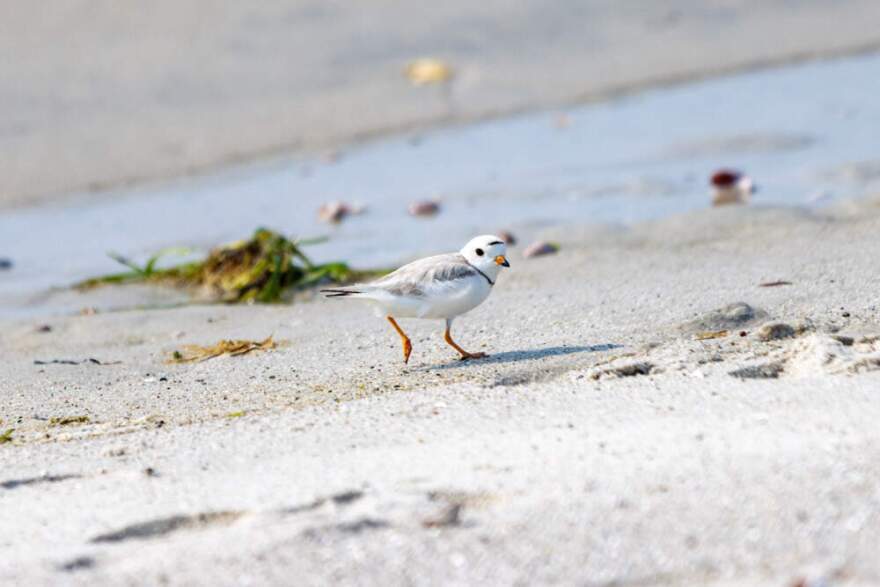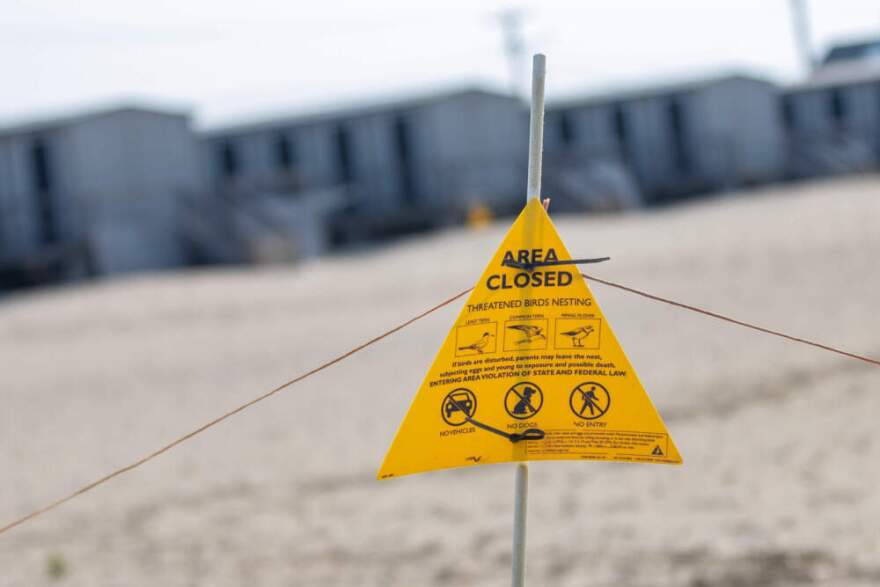
Lyra Brennan stood on a near-empty beach in Barnstable, scanning the sand for adult piping plovers and their newborn chicks.
A plover chick is about the size of a cotton ball, and the same color as the speckled sand. So they’re hard to spot with the untrained eye.
But “once you see them, it’s like you start seeing them everywhere,” said Brennan, the director of Mass Audubon’s Coastal Waterbird Program. She peered through her binoculars. “I mean, I hear them in my sleep.”
Suddenly Brennan spotted a chick near the waterline, jogging on its spindly legs. The little poofball was undeniably adorable.
“This never gets old,” Brennan said.

The tiny shorebird with a telltale squeak — that’s the “piping” in its name — has made a remarkable recovery in Massachusetts. When the federal government listed piping plovers as “threatened” in 1986, there were only about along the whole Atlantic coast, and fewer than 200 in Massachusetts. With protections, the birds have rebounded, their overall numbers more than tripling.
Most of the success has been in Massachusetts. Experts aren’t quite sure why the state has seen such a bird bonanza compared to others, but it’s home to , nearly half of the entire Atlantic coast population.

Those are “pretty incredible numbers for a species whose population was so depressed,” said Carolyn Mostello, a coastal waterbird biologist for MassWildlife. “Massachusetts residents should be really proud.”
This bird version of the “” comes despite a long and varied list of threats. Piping plovers nest on the beach, laying eggs in shallow scratches in the sand. The birds feed along the waterline, running back and forth across the beach. This open lifestyle leaves them vulnerable to predatory birds like grackles and crows, feral cats, skunks, coyotes, and pet dogs; storms and floods that wipe out nests; and habitat loss from coastal erosion and development.
Another threat: huge summer crowds, which include some visitors who resent beach restrictions and willfully ignore them, and some who accidentally step on the tiny birds.
“This beach will be absolutely full of people on a nice hot summer day,” said Brennan. But somehow most plovers navigate the crowds.
“That’s kind of the magic — we can have it all,” she said.

But in some southern states, including Maryland and Virginia, , so the bird remains on the list of federally threatened species. All the states with plover populations have federal protections, use similar interventions, and have dedicated volunteers to count birds and warn beachgoers away from nests, said Maureen Durkin, a wildlife biologist with the U.S. Fish and Wildlife Service. So experts can’t fully explain why Massachusetts is leaving other states in the dust.
“There are so many factors that could be contributing,” said Durkin.
First, she said, Massachusetts has a lot of coastline, with beaches facing in all directions. That can be helpful to plovers when a storm hits.
“Maybe the east-facing beaches got hit really hard, but the north-facing beaches are okay,” she explained. “So we have a lot of nests that survive flooding.”

Massachusetts may have another advantage, said Durkin: food.
Plovers in some southern states . In addition to the ocean, they also need access to mudflats or a calm body of water, like a bay, where they can forage. Experts aren’t sure what’s driving this need, whether it’s the quality of food, the landscape, predators, or something about the birds themselves.
Plovers in Massachusetts, on the other hand, have multiplied by feeding near the ocean alone; the seaweed washed up on New England beaches seems to supply an abundant source of food.
“There’s lots of bugs in there, they’ve got tons of stuff to chomp on,” Durkin said. “And you get that on all kinds of beaches, from heavily developed ones to really remote ones.”

That was evident on the Cape Cod beach where Brennan and her colleague , Coastal Waterbird Program Manager Jamie Infanti, pointed out plovers pecking at piles of seaweed, shells and other debris.
“They’re going to like this fresh seaweed,” said Infanti. “It’s going to have a lot of little bugs and flies. You’ll sometimes see chicks like chasing flies around the beach, which is really fun to watch.”
But if food and habitat are behind the Massachusetts plover comeback, then there’s no easy way to transfer that benefit to southern states. And with climate change, Massachusetts may lose its advantage.

“We’re currently seeing the impacts of climate change, but into the future it’s an even bigger concern,” said Brennan. With rising seas and stronger storms eroding beaches, habitat may disappear, she said. And warming waters may alter the food supply.
“I think the more research, the better, so that we can keep preparing and keep figuring out where the best places are for the birds to be, as climate change continues to accelerate,” she said.
There’s another looming threat to the plovers: a possible rollback of federal protections under the Endangered Species Act. The Trump administration recently that would — people would still be prohibited from directly hurting or killing threatened animals, but they could more easily destroy habitats.

Chris Allieri, the founder and executive director of the nonprofit , said he’s hopeful federal lawmakers will put politics aside and stand up for endangered animals.
“ To this day, wildlife conservation and endangered species protection is still an issue that unites Republicans and Democrats,” said Allieri. And the piping plover is the perfect poster child, he said.
“ I think a society that comes together around a little bird, if that’s something we can strive to be, we’re going to be better people overall,” he said.
This article was originally published on
Copyright 2025 WBUR


